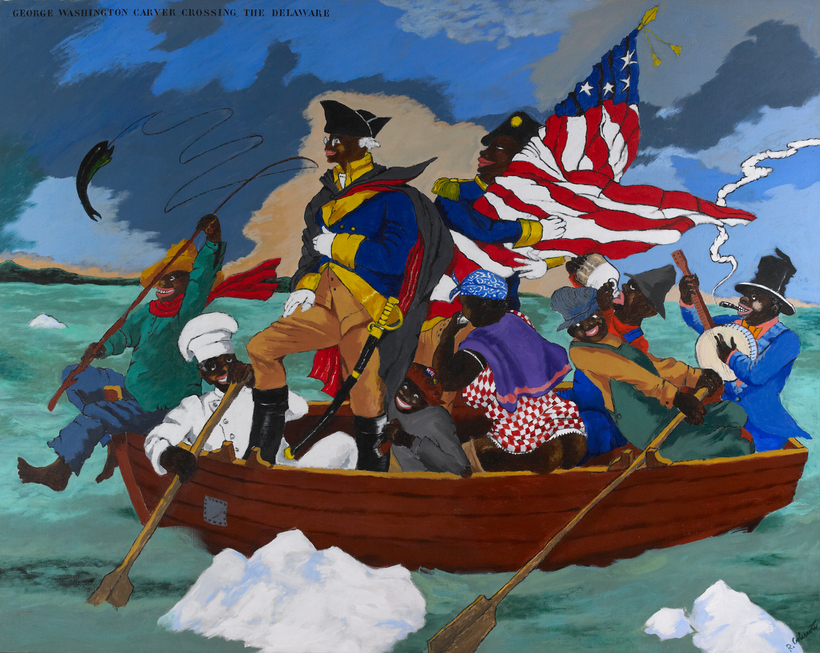When Lowery Stokes Sims was a young curator at the Metropolitan Museum of Art, a painting she loved was offered on loan to the museum. During a test run in the galleries, she gazed up at Eat Dem Taters (1975), Robert Colescott’s keen, bitter twist on Van Gogh’s The Potato Eaters. In Colescott’s work, Van Gogh’s glum diners are Black, grinning ear to ear with goggly eyes, and seemingly grateful for table scraps. Sims’s colleague, she recalls, said, “You can either hang this or you can have a quiet summer.” The year was 1979. Sims opted for quiet and took it down. But what will happen this summer?
On June 30, the New Museum in New York City opens “Art and Race Matters: The Career of Robert Colescott.” Born in Oakland in 1925, and trained in California, the artist famously studied with the master Fernand Léger in Paris, and taught in Cairo and elsewhere for decades. Since his death, in 2009, this is the first full-blown traveling retrospective dedicated to the polarizing painter. It is co-curated by Sims and the scholar Matthew Weseley, and coordinated by the New Museum curator Gary Carrion-Murayari.

Throughout a career that has taken her to top positions at the Studio Museum of Harlem and other institutions, Sims has championed Colescott. “But in the beginning,” she notes, “there were a lot of people—including Black artists, including brown artists—who jumped on me: Why are you supporting that artist? If much contemporary Black art felt like jazz, I would say Bob was honky-tonk.”
Colescott was of mixed race and reticent about discussing his racial identity. But he did embrace his Blackness in the second half of his life as his art became a lightning rod for controversy. His best-known body of work is outrageous. And passionate. It catalogued, lampooned, and rendered caustic Black stereotypes, often inserting them in classic paintings and chiding such art-world greats as Delacroix, Manet, and de Kooning for the invisibility of people of color in their works. While institutional acclaim has been slow in coming, earlier this year the George Lucas collection purchased a Colescott—price: $15.3 million—for inclusion in Lucas’s planned Museum of Narrative Art, in Los Angeles.

That very work is also serving as the centerpiece of the New Museum show. A great American painting about the failures of America, it is Colescott’s caustic, brilliant George Washington Carver Crossing the Delaware: Page from an American History Textbook. A 1975 rejoinder to Emanuel Leutze’s famed presidential tribute of 1851, Colescott’s version is a roundup and a send-up of historical caricatures of Blacks—from minstrelsy to a mammy to token Black achievers included in the history textbooks that infuriated Colescott as a child.
Eat Dem Taters, meanwhile, is no longer in the curatorial basement—it too is featured in the New Museum show. In a 1979 interview held in the archives of the New Museum, Colescott explained that the painting is “a frontal, brutal attack on the myth of the happy darkie.”

Contemporary-art collector Adam Lindemann, a financial supporter of the museum and of this show, says people who don’t like Colescott’s work are missing something. “They see provocation, they see kitsch, they see art that pushes the boundaries of louche themes and outrageous narratives of sex and racism.” Colescott, he continues, “doesn’t suit those nervous about standards of good taste.”
Tastes, though, can change radically over time. Colescott eventually went on to become the first solo Black artist to represent the U.S. at the Venice Biennale, in 1997. Today, he is presented as a standard-bearer for figurative painting when it was out of fashion, as a forerunner of appropriation, and as an early commentator on identity politics. His transgressive work is given credit for influencing artists such as Ellen Gallagher, Kerry James Marshall, Kara Walker, and Kalup Linzy.
Perhaps most importantly, says Sims, people may finally accept not only his subject matter but the fact that Colescott was a great painter. —Alexandra Peers
“Art and Race Matters: The Career of Robert Colescott” opens June 30 at the New Museum, in New York
Alexandra Peers is a New York–based writer

 Discover
Discover